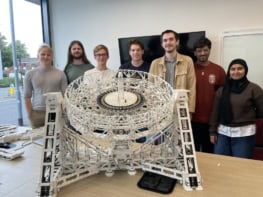Enrico Sacchetti argues that the saying “a picture is worth a thousand words” is truly apt when it comes to the photography of large physics experiments

Photography is a universal language. Humans are visual creatures and we instantly relate to images that make a subject come alive. Our eyes are immediately drawn to an image on the printed page or on the screen. With just a quick glance, we see all of its complexities: forms, patterns, structures and colours.
Photography is also a science – the science of light and optics. Ever since the French artist Louis Daguerre invented the photographic imaging technology, known as daguerreotype, in 1839, photography and science have formed a lasting bond that is only set to continue in the coming century. Indeed, careful observation of evidence lies at the core of the modern scientific method, with photography having always been valued as an objective observational technique for probing and documenting the natural world
Science has used photography, for example, to gather data that cannot be detected or processed by the eye, or by “slowing down” processes that are too quick for humans to visualize. Indeed, photography in science often has several functions – from being used as scientific evidence to represent a broad concept or idea to even being an independent piece of art. Indeed, photography has always wavered between art and science, often resting in the margins occupied by both fields.
Photography also provides an efficient means of communicating science to the general public and the scientific community. It is simply one of the best ways to make science accessible and understandable. Photography helps researchers demystify science, especially when dealing with concepts that non-scientists do not comprehend. Great photographs help tell a story by creating a visual narrative, captivating and maintaining the reader’s attention and sparking their curiosity.
In our frenetic and social-media obsessed lifestyles, people are losing the ability to invest time in reading beyond 280 characters. And that is exactly where the power of strong photography comes in. Not only does an image quickly synthesize the essence of an article but it also captures the reader’s attention long enough for them to read on.
As a science photographer I am fascinated by how particle physicists construct and utilize extremely large and complex detectors such as CMS and ATLAS at CERN’s Large Hadron Collider. They are some of the biggest machines ever built, searching for the smallest particles in the universe. In astronomy, meanwhile, digital cameras have opened up even more possibilities. Ultra-sensitive light sensors and the use of long exposures (without large colour shifts) were simply not possible before the digital photographic revolution. The added sensor sensitivity and increased time exposures make distant faint objects in the sky now clearly visible.
Eye for beauty
So, what makes a great photograph? Well, that is usually in the eye of the beholder, but besides the obvious correct exposure and an in-focus image, we can certainly agree on a few points. One is a unique and strong composition. This could perhaps reveal an interesting aspect of the instrument or experiment, or show a singular perspective that has rarely been seen before. Another is lighting, which can be used to enhance the photograph by adding drama, or by imbuing it with a particular mood. Finally, giving an image a sprinkling of mystery helps to grab our attention and speak to our emotions.
My own photography (see above) tends to lie more towards the artistic end of the science–art spectrum and is almost exclusively about aesthetics. I look at the geometry and symmetry of an instrument, letting it guide me to the correct composition and unique point of view. I am interested in showing the reader the beauty, as well as the complexity, of these behemoth machines. These detectors have kilometres of wires, pipes and cables criss-crossing each other in endless repeating shapes and patterns and, when photographed just right, these shapes and patterns are pleasing to the eye.
I am interested in showing the reader beauty, as well as complexity
A good image lets us appreciate the ingenuity that was necessary for the conceptualization and realization of these massive experiments. The importance of a good photograph is that its uniqueness, beauty or mystery grabs and holds the reader’s attention just long enough to liberate some of their precious time to read the accompanying article.
If as a photographer I can achieve that, then I have done my job.



